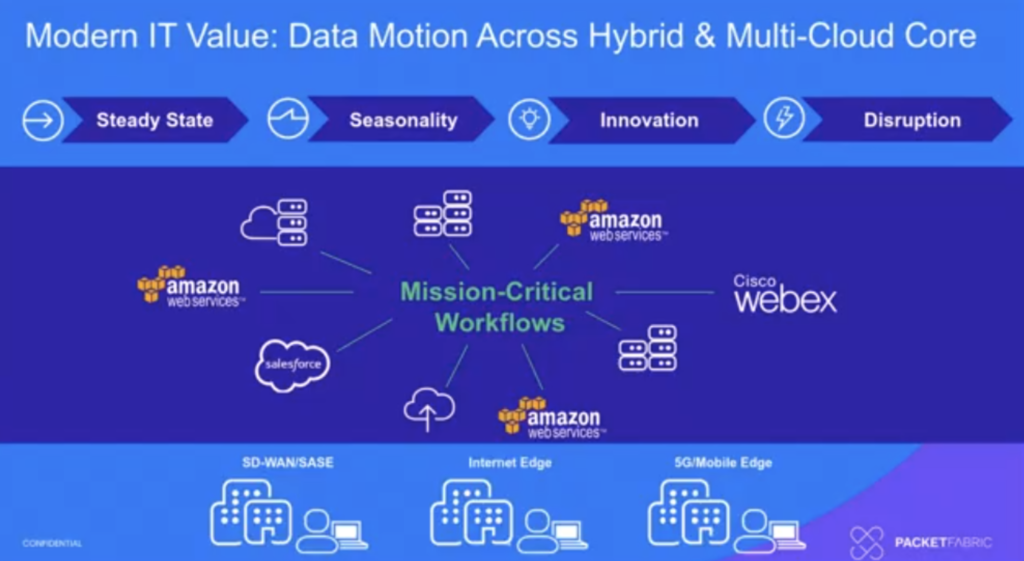
How to Increase the Value of Data in Motion With PacketFabric and AWS
The velocity with which an organization can move its data to applications and services determines how much value can be created to power its business, according to Amazon Web Services (AWS) and PacketFabric.
While traditional connectivity schemes create friction or even blockages to data in motion, PacketFabric’s on-demand, private optical network connectivity to the AWS Direct Connect network service can increase the value of data in motion, the companies say.
“Today, if you’re in IT, I think it would be sort of ridiculous to think about the notion that anybody wants you to do anything slower,” Alex Henthorn-Iwane, CMO at PacketFabric, said June 23 during the webinar “Increasing the Value of Data in Motion with PacketFabric and AWS.”
“If you think about how data gets value, one of the most obvious things we can think about is user experience,” he noted. “Everybody knows… that folks want snappy performance for their applications. That’s a really easy thing to think about.”
AWS, meanwhile, is a “tentpole” service used by many organizations, he said. An organization’s data and workflows may be moving between AWS and other companies and services, including Cisco Webex or Salesforce, when using hybrid or multi-cloud services. “There can be a lot of volumetric data that’s moving across” these services and payments may be getting processed also, Henthorn-Iwane said.
“There’s a lot of ways in which it’s not just about volumetric user traffic getting to applications, which is the most familiar thing in terms of creating value for that data in motion,” he pointed out. “There’s all these other volumetric use cases, some of which just need privacy and security, some of which need low latency.”
Another significant aspect of this is that we are not always dealing with a steady state, he said, noting there are also seasonality, innovation and other projects that an organization must take on requiring the movement of data, and there is also disruption – the “surprises where you have to just make something happen,” such as when you acquire another business and must “stitch everything together and move a bunch of data around.”
“All that motion is how the data creates value,” he said, adding: “How you do that matters because” of reasons that include cost efficiency.
PacketFabric is “essentially a totally automated, cloud-like private optical network” and is on demand like a cloud service, he pointed out, noting the platform delivers diverse connectivity services, including point-to-point connectivity, hybrid cloud connectivity, multi-cloud routing and any-to-any networking. PacketFabric’s modern approach is adaptive, agile, connected, secure and cost effective, according to the company.
 The AWS-PacketFabric Solution
The AWS-PacketFabric Solution
“When you’re connecting to AWS, you have a few different options in terms of how you’re going to do that,” according to Adam Blackington, partner solutions architect at AWS.
“We certainly have the traditional Internet connectivity option,” such as when you are home using an Internet Service Provider (ISP), he noted.
But AWS also offers two other options: secure encrypted connectivity via the public Internet and global private network connectivity via AWS Direct Connect, which consists of private network connectivity between AWS and customer on-premises locations without using the public Internet, he said.
Direct Connect is secure and is “like having a direct pipe from wherever you are, your source and destination,” he explained, adding it offers “private, reliable connection to AWS backed by” a service level agreement (SLA) that “offers consistent performance and reduced bandwidth costs.”
Reasons for organizations to consider using Direct Connect include: Consistent network performance, the ability to manage cost risk as demand scales because of its affordability, to assure service uptime, reliability (the delivery of resiliency and fault tolerance), and security (private and/or encrypted connectivity), he said.
There are several benefits of using Direct Connect, including: the consistent network performance, service assurance with a 99.99% uptime SLA, easy and seamless scalability globally, and the fact that you can pay as you go without capital expenditure, he said.
Performance is so good because “you’re not competing against anyone else for traffic, either egress or ingress into the AWS network,” he explained.
AWS Direct Connect partners include PacketFabric. If the user is a PacketFabric customer, he or she would work with PacketFabric to get the Direct Connect option set up, he said, noting PacketFabric has “direct connectivity already into the AWS backbone so they’re able to provision that hosted connectivity for you, near instantaneously.”
A demo was then provided by Keith Burns, director of technical marketing at PacketFabric.
To see the full webinar, click here.
